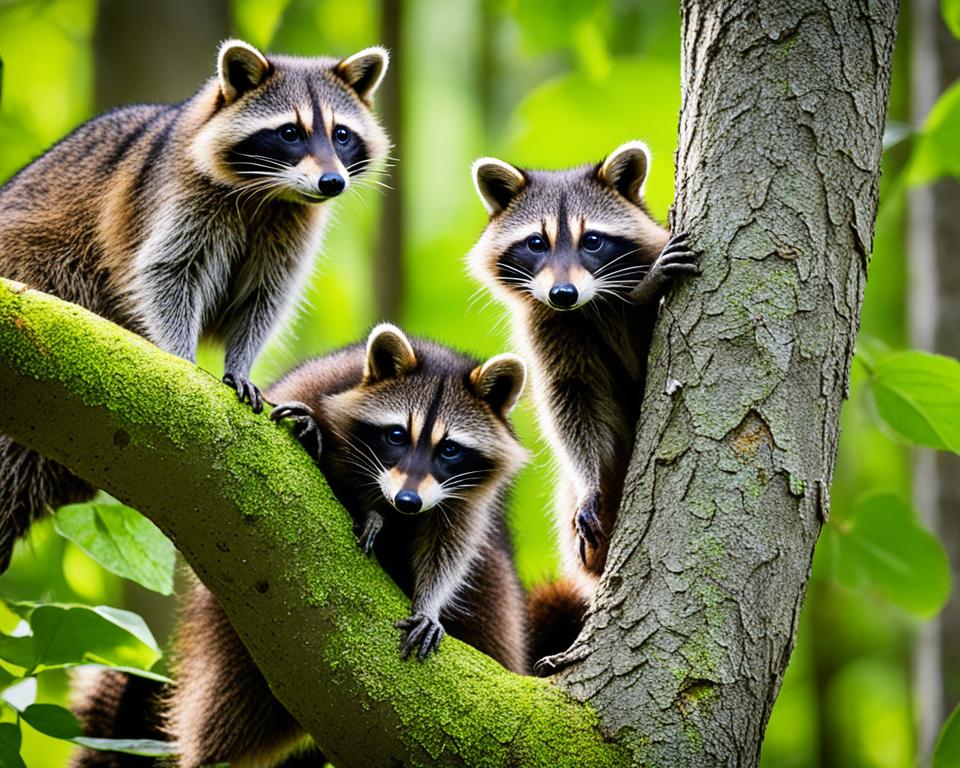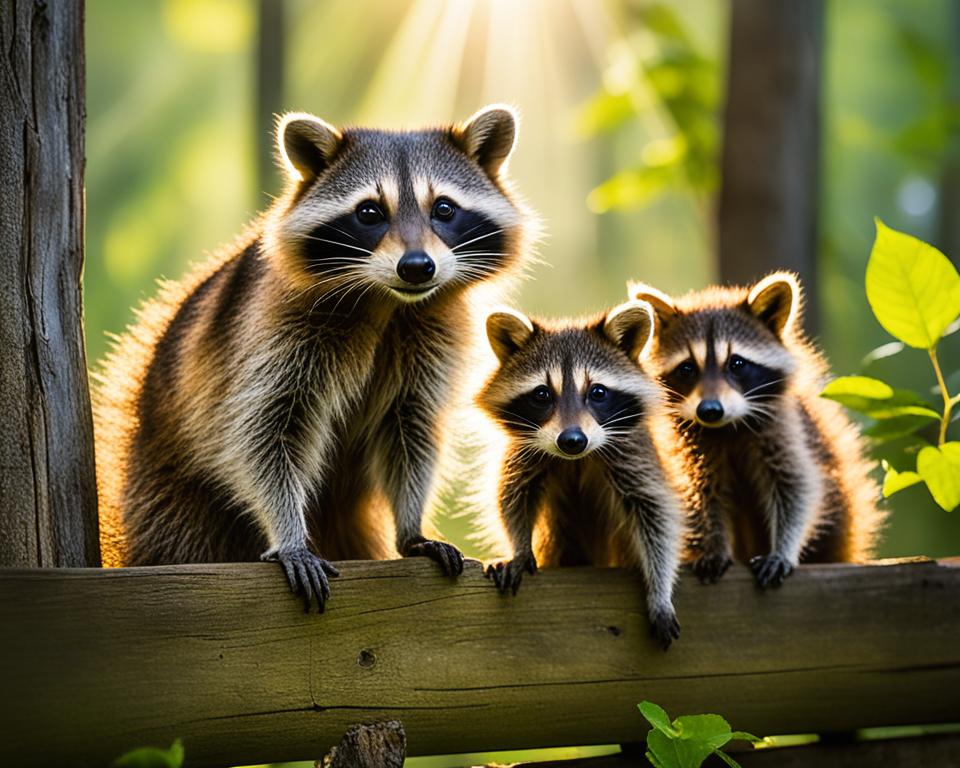
Cades Cove Raccoons: Guide to Safe Wildlife Viewing
Welcome to Cades Cove, a haven for wildlife enthusiasts and nature lovers alike. Located in the Great Smoky Mountains National Park, Cades Cove is home to a thriving raccoon population and offers visitors the chance to observe these fascinating creatures up close. In addition to raccoons, the park boasts a diverse array of wildlife, including white-tailed deer, elk, black bears, turkeys, and more.
As you explore the park, it’s essential to practice responsible wildlife viewing to ensure the safety of both the animals and yourself. By following a few simple guidelines, you can have a memorable and respectful experience while enjoying the wonders of Cades Cove’s wildlife.
Let’s take a closer look at raccoon habitat, behavior, conservation efforts, and valuable tips for observing wildlife in a responsible manner. Whether you’re an avid photographer, a nature enthusiast, or simply seeking a connection with nature, Cades Cove is a treasure trove of wildlife waiting to be discovered.
Raccoon Habitat and Behavior in Cades Cove
Raccoons in Cades Cove thrive in their diverse habitat, showcasing their adaptability and resourcefulness. These intelligent creatures can be primarily found in the dense forests near water sources, where they actively hunt for their preferred meals. Their diet includes insects, salamanders, crayfish, and small mammals. With their dexterous paws and sharp claws, raccoons exhibit excellent climbing and foraging skills.
Being primarily nocturnal, raccoons in Cades Cove display their cleverness and curiosity under the cover of darkness. Their night-time activities and behavior make sightings during the day relatively uncommon. However, visitors who are staying in accommodations near Cades Cove or in the Cades Cove campground may have the chance to observe these fascinating creatures during the evening or early morning hours.
Raccoons are known for their agile nature and their ability to adapt to various environments. In Cades Cove, they have successfully established their habitats, making them an integral part of the diverse ecosystem. Their presence contributes to the overall balance and biodiversity of the area, making wildlife viewing a rewarding experience for visitors.
While observing raccoons in their natural habitat, it’s essential to maintain a respectful distance to ensure both the safety of the animals and the preservation of their natural behavior. Remember that raccoons are wild animals and should be appreciated from afar.
Conservation of Cades Cove Raccoons
The raccoon population in Cades Cove plays a crucial role in preserving the natural balance of the park’s ecosystem. These adaptable creatures contribute significantly to the overall biodiversity and help maintain a well-functioning food web in the area. To protect the wildlife, including the raccoons, the Great Smoky Mountains National Park has implemented strict regulations to prevent human disturbances.
It is strictly prohibited to approach, feed, touch, tease, frighten, or intentionally disturb wildlife in any way. By respecting these guidelines, visitors can ensure the well-being and safety of both the animals and themselves. The park encourages wildlife enthusiasts to observe from a safe distance, using binoculars, spotting scopes, and telephoto lenses to enjoy wildlife without causing any disruptions.
Tips for Responsible Wildlife Viewing in Cades Cove
When visiting Cades Cove, it is essential to practice responsible wildlife viewing to ensure the safety of both animals and visitors. By following these tips, you can have a memorable and respectful wildlife experience:
- Observe wildlife from a safe distance – It is important to maintain a distance of at least 150 feet from animals such as raccoons, bears, and elk. This ensures their safety and minimizes the risk of disturbances.
- Do not approach or feed wildlife – Feeding or approaching wildlife can lead to habituation and potentially dangerous interactions. It is against park regulations to feed any wildlife, including raccoons. Let them forage and hunt for food naturally.
- Use binoculars and telephoto lenses – These tools allow you to get a closer look at wildlife without the need to get too close to the animals. This respects their habitat and keeps them undisturbed.
- Stay on designated trails – Stick to established trails to minimize disturbance to the natural habitat and reduce the risk of encountering wildlife unexpectedly. Respect the park’s guidelines and maintain the integrity of the ecosystem.
- Respect wildlife’s space – If you notice any changes in an animal’s behavior due to your presence, it is important to slowly back away. This allows the animal to feel safe and resume its normal activities. Observing from a distance ensures their well-being.
Remember, responsible wildlife viewing in Cades Cove not only protects the animals but also preserves the natural beauty of the park for future generations.
Other Wildlife in Cades Cove
In addition to raccoons, Cades Cove is home to a diverse range of wildlife. Visitors may have the opportunity to encounter a variety of fascinating animals during their visit to the park. Some of the notable wildlife species that can be spotted in Cades Cove include:
White-Tailed Deer
One of the most iconic species in the park, white-tailed deer are often seen grazing peacefully in the meadows of Cades Cove. Their graceful presence adds to the natural beauty of the area.
Wild Turkeys
Keep an eye out for wild turkeys, known for their distinctive feathers and colorful displays during mating season. These birds can often be spotted roaming the open fields of the Cove.
Coyotes
Coyotes, known for their adaptability and stealth, are present in Cades Cove. While elusive, they play an important role in the ecosystem as predators.
Skunks
Although often associated with their distinctive odor, skunks can also be observed in Cades Cove. These nocturnal creatures are part of the diverse wildlife population.
Black Bears
Cades Cove is home to a healthy population of black bears. These magnificent creatures are often seen foraging for food or climbing trees in search of sustenance.
Otters and Beavers
Water-loving mammals like otters and beavers can be found in the streams and creeks of Cades Cove. Their playful behaviors and impressive building skills are a delight to observe.
Bobcats and Foxes
The Cove is also home to elusive predators such as bobcats and foxes. These creatures are skilled hunters and are a testament to the diverse wildlife ecosystem of the park.
Bird Species
Cades Cove is a paradise for birdwatchers, with various bird species making the area their home. Keep your binoculars handy to spot beautiful birds, including songbirds, raptors, and waterfowl.
With such a rich biodiversity, Cades Cove offers wildlife enthusiasts an incredible opportunity to explore and observe the wonders of nature. Remember to maintain a safe distance and observe these animals from afar to ensure their well-being and preserve the natural balance of the ecosystem.

Best Times to Spot Raccoons in Cades Cove
Raccoons in Cades Cove are primarily nocturnal, making the evening and early morning the best times to catch a glimpse of these fascinating creatures. As they emerge from their dens and venture out to hunt for food, visitors may have an increased chance of encountering raccoons during these hours of the day. Their remarkable adaptability allows them to thrive in Cades Cove, where they navigate the dense forests near water sources.
Although raccoons are skilled at evading human presence, those staying in accommodations near Cades Cove or the campground may be fortunate enough to observe raccoons during the dark hours. While raccoons prefer to stay hidden during daylight, their natural behaviors can be observed under the cover of darkness.
To enhance your chances of spotting raccoons, consider exploring the nearby areas of Cades Cove that offer a close proximity to their habitats. But always respect their space and observe from a safe distance to avoid any disturbance. It’s in these moments of observation that we can truly appreciate the wonder of nature’s nocturnal creatures.
Safety Tips for Wildlife Encounters in Cades Cove
When experiencing the wonders of Cades Cove and encountering its diverse wildlife, ensuring the safety of both yourself and the animals is of paramount importance. By following these guidelines, you can have a safe and enjoyable wildlife viewing experience:
Maintain a Safe Distance
To prevent disturbance to the animals and potential harm to yourself, it is crucial to maintain a safe distance of at least 150 feet when observing wildlife in Cades Cove. Respecting their space allows them to go about their natural behaviors undisturbed.
Do Not Approach or Feed Wildlife
Feeding or approaching wildlife disrupts their natural behavior and can have harmful consequences for both humans and animals. It is important to admire them from afar and avoid offering them any food. Let them forage for their own sustenance in their natural habitat.
Use Appropriate Equipment
Binoculars, spotting scopes, and telephoto lenses are ideal tools for close-up wildlife observation without encroaching on their territory. By using this equipment, you can enjoy a detailed view of the Cades Cove raccoons and other wildlife while maintaining a safe distance.
Stay on Designated Trails
Minimize disturbances to the raccoon habitat and reduce the chances of unexpected encounters with wildlife by sticking to established trails. By following the marked paths, you can explore the beauty of Cades Cove while respecting the boundaries of the local fauna.
“Maintaining a respectful distance and ensuring minimal interference allows wildlife to live naturally and safely in their habitat,” says Park Ranger Sarah Thompson.
Observe Behavior Changes
Pay close attention to the behavior of wildlife. If an animal shows signs of agitation or changes its normal activities due to human presence, it is an indication that you are too close. Slowly back away to provide the animal with the space it needs to resume its natural behavior.
Remember, practicing responsible wildlife viewing not only ensures your safety but also contributes to the preservation of the delicate ecosystem and the well-being of the Cades Cove raccoons and other wildlife that call this magnificent place home.
Respecting Wildlife and Park Regulations in Cades Cove
Preserving the natural environment and protecting the raccoon population in Cades Cove is of utmost importance. To ensure the well-being of these fascinating creatures and maintain the delicate balance of the ecosystem, it is essential to follow park regulations and respect wildlife. Please remember that feeding, approaching, or disturbing wildlife is strictly prohibited.
Cades Cove is home to a diverse range of wildlife, including raccoons. However, it is crucial to understand that these animals are not tame and approaching them can be dangerous for both visitors and the animals themselves. By maintaining a safe distance and observing from afar, you can enjoy the beauty of Cades Cove’s wildlife while keeping them safe and undisturbed in their natural habitat.
Always remember to familiarize yourself with the park’s rules and regulations to ensure a safe and enjoyable experience for everyone. By respecting wildlife and adhering to park regulations, you contribute to the conservation efforts and help preserve the raccoon habitat in Cades Cove for future generations to appreciate.
Source Links
- https://www.cadescove.net/wildlife/
- https://www.nps.gov/grsm/planyourvisit/wildlifeviewing.htm
- https://www.visitcadescove.com/cades-cove-wildlife-2/